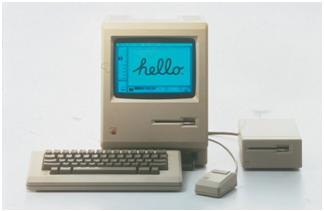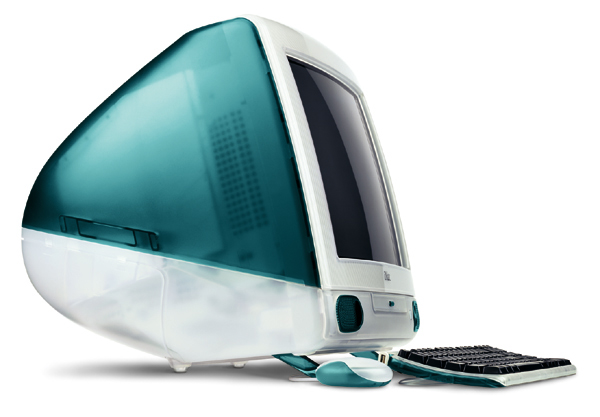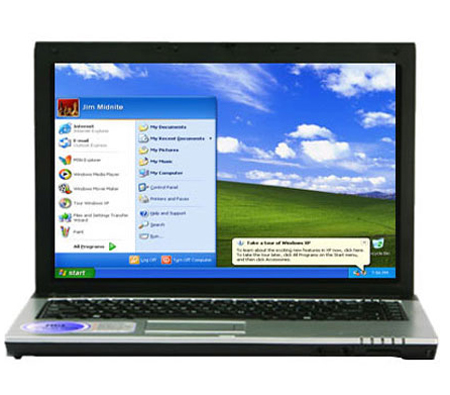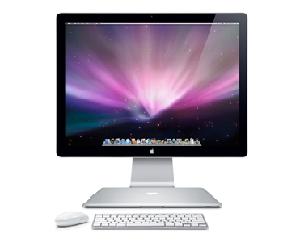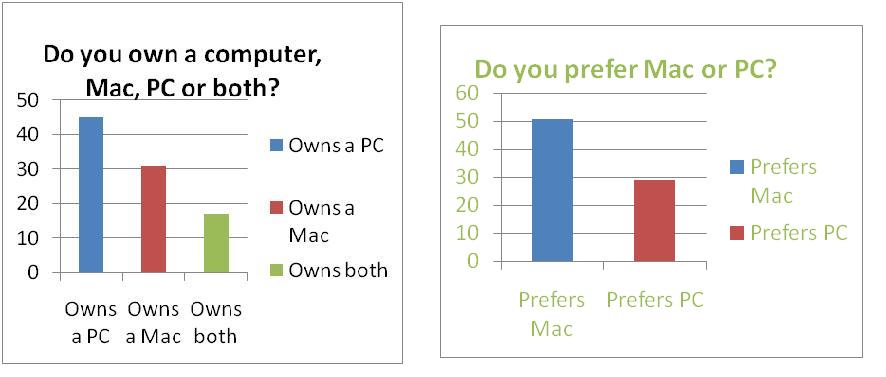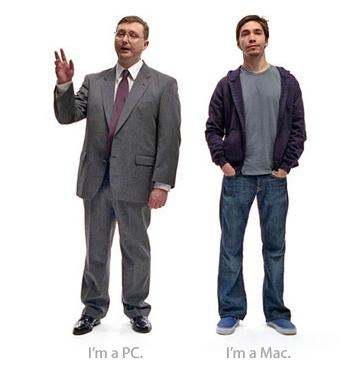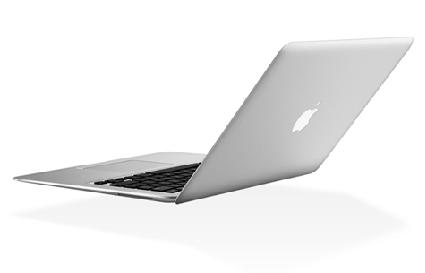Mac vs PC
Contents
Topic
The evolution of computers:Mac vs. PC
Group Members
Ashley Baraluk, Jeff Spring, Imran Mukadam, Parmpreet Sooch
Initial Statement
In recent years, the market for computers, especially laptops, has become extremely competitive. The two main competitors that have been established are Macintosh and “PC”. PC is a general term that was phrased in the popular Macintosh commercials which described the other computer making companies in the industry that relied on the previous model of computers. Apple created the first computer with user friendly programs and software which was completely innovative within the industry. Due to these new developments Macintosh has experienced an extreme rise in popularity and profitable sales of its products. The PC still dominates the industry and is lead by Hewlett-Packard(HP), but Apple is quickly closing the financial gap. Both devices have their separate advantages and disadvantages, and only by analyzing these in depth, can the consumer make the best educated choice.

History and Background
History of Mac
In the late 1970’s a Macintosh employee by the name of Jef Raskin started the development of the first Macintosh computer. The project was soon taken over by Steven Jobs which eventually lead to the birth of the first Macintosh computer which was driven by the “lisa” program. The original Macintosh computer, 128K, was released on January, 24, 1984 two days following their famous advertising debut that was aired during the super bowl. The 128K was subjected to heavy criticism concerning its memory capacity which lead to its terrible sales. Between 1990 and 1998 there is a lot of speculation which assumes that Macintosh remained static due other companies’ dominance within the market (IBM). There was a great financial gap for Macintosh which picked up in 1998 with the Mac-all-in-one (iMac. This computer combined multiple consumer- level desktop models which proved to be extremely popular to the average individual and helped revamped the organization’s image. Quickly following the iMac success was the evolutionary Mac book Pro in January 2006 and the Mac book in May 2006. These computers are based upon a vertical integration model created by Macintosh which supports all hardware and is built into all of their computers. Presently, the target consumer group for the Mac computer are the following: creative/personable people, the home computer user and students.
History of PC
One of the first uses of the term “personal computer” (PC) appeared in a November 3, 1962 New York Times article which documented John W. Mauchly’s vision of future computing. Mauchly stated, “There is no reason to suppose the average boy or girl cannot be master of a personal computer.” The manufacturer Hewlett Packard referred to their product this way six years later when they advertised their “Powerful Computing Genie” as “The New Hewlett Packard (HP) 9100A personal computer.” PCs continued to develop and gain recognition over the years and in 1981 the first PC hit the market with the introduction of the IBM 5150; since then, many companies and standards have been created and replaced in the market. Over the years two categories of PCs have emerged: PC's made by Apple, and PC's made by everyone else (Compaq, Dell, HP, IBM, Sony, and Toshiba, just to name a few). In the 1980's and 90's, the sector of PC's not manufactured by Apple largely dominated the sales of the PC market due to the fact that at this point there weren’t many Macintosh computers in the market; therefore their software selection was lower and less appealing to consumers. PC’s main advantage at that time, one that is now slowly diminishing as time goes on was that many popular software titles were not available for the Mac platform, and so the PC had the widest selection of programs available. The history of the Windows Desktop Product evolution is an extensive one spanning from 1983 when Microsoft initially announced the Windows product, to their present day version, Windows Vista. Listed below are just a few of their major product releases over the years. When the first PC hit the market with IBM (as mentioned above), the software it launched with was Microsoft PC-DOS 1.0; Microsoft officially released the first version of the Windows operating system in 1985 with Windows 1.0. In 1987 Windows version 2.0 was released, followed by Windows version 2.1, later renamed Windows 286. In 1990 Windows/286 and Windows/386 were merged to make Windows 3.0. In 1992 Windows version 3.1 was released with significant changes including support for multimedia, which enabled sound and music to be played. In 1993 Windows NT was introduced enabling developers to write powerful programmes, also supporting 32-bit programming and Pentium microprocessors. Its name NT stood for “New Technology” which represented Microsoft’s completion of a project begun in the late 1980s to build an advanced new operating system from scratch. In 1995 Windows 95 was launched after much delay and just as much hype. Windows 95 provided a new user interface look, which was then transported to Windows NT Version 4.0. This was the first version of Windows that didn't require the user the install DOS first, the user interface catches up with the Mac at this point. In 1998 Microsoft launched Windows 98, the last major version of Windows running on top of DOS. Windows 98 was the first version of windows built specifically for consumers. Windows 98 integrated Internet Explorer 4 and supported numerous new device types, from USB to ACPI power management. Future consumer versions of Windows were built on the NT kernel. In 2001 the first version of Windows XP was launched followed by XP professional, XP home edition, XP 64-bit edition, and then the XP media center edition. On January 30, 2007 Microsoft released Windows Vista and Microsoft Office 2007, the latest Microsoft Windows software available for consumers and businesses at present day.
Comparative Analysis
Pro's and Con's of PC's
Pros
Cheaper hardware and software components available to PC companies have resulted in PCs being more affordable than Macs. The PC market is very competitive with a number of vendors in fierce competition with each other, which as a result has shown lower prices and more choices to the PC consumer. As a result of the competitive market, the latest and greatest technology is also available sooner, and priced as cheaply as companies can sell it to PC users. Macs have become newly affordable, whereas PCs have long been affordable, and unlike Macs, there are many low-cost PC models available today’s market. “Your range of choices in the Windows world is MUCH wider than in the Apple world.” Both Macs & PCs run Intel processors with two critical differences worth mentioning. The drawback for Mac is that they are limited to using pricey Intel processors which inhibit them from offering low cost PCs. They use conventional Core2 and high-end Xeon processors, and others running at speeds of 2.4 GHz to 3.2 GHz; those with the higher speeds result in faster PCs. Here, the advantage for all other PCs separate from Mac, Windows-based PCs, is that they offer a much wider variety of processor including the same Intel chips that Apple uses, but offering a wider choice of speeds ranging from 1.06 GHz to 3.2 GHz. PCs are also able to use Intel CPUs that Apple doesn’t offer such as Pentium and Celeron chips which cost less, resulting in a lower priced PC. PCs also have available to it CPUs from AMD (a competitor of Intel), which can be used with the Intel chips but cost less, also resulting in a lower priced product. A wide variety of Windows PC companies manufacture almost any combination of processor and component one can think of. Some of the systems created are a comparable match to Apple’s models, offering the same size and power at similar prices. The glaring advantage here for the PC are the countless other variations of systems that use lower-cost Intel chips such as the Pentium and the Celeron, or even cheaper processors from AMD – offering a mixed and matched market of components of practically all capacities, thus, a market at a price range for every consumer’s budget.
“If you want the freedom to choose from a wide range of system components, peripherals, and applications, you are most likely a PC.” It is no secret that PCs have been able to offer a wider selection of software. If you need to do something on a computer, you are most likely going to be able to find a variety of software products available for Windows to do it. “Since PCs are the most popular type of computer sold, they are the most compatible type of computer currently available for both hardware and software.” PC computers are built with a version of Microsoft Windows. This operating system (OS) standard amongst PC companies has long resulted in Windows as the standard OS of which much of the software made for computers is created for. Many consumers feel that the main advantage to buying a PC is having the most compatibility with all available hardware and software in the PC market. Gamers especially feel this way, because there is much more software available for PCs, they are better than Macs for gaming, since most popular, quality games are created for the PC.
Macs have always contained wide-ranging Plug & Play capability permitting its users to plug in just about any peripheral or connect to a network, and without input from the user required Mac “sees” the new equipment or environment. With the release of Window’s Vista, Windows PCs are now able to compete in this department too. “Vista offers 12,000 drivers for various peripherals (printers, optical drives, scanners and so on) and succeeds in hands-free installation far more often then it fails.” There are subtle differences between warranties for a PC and Mac that people in the market for a PC should be aware of. Windows based PCs require anti-virus software which you need an annual subscription to obtain. Both Macintosh and Microsoft release an OS upgrade once a year, the Windows update is free, the Mac’s is not with its most recent OS upgrade priced at a steep $129. Also worth mentioning is that Apple’s phone support lasts only 90 days after which you will be required to pay $49 per call for live troubleshooting support, while most Windows PC makers offer free phone support for a year.
Cons
The PC is a very useful and advanced computer, however, it has disadvantages as well as advantages. One of the main disadvantages of a PC is that, when it comes to laptops, PC’s have a very high energy requirement. This drains the battery of a laptop very quickly, thus making it quite inconvenient, especially for travellers, and students. This low battery life makes it quite difficult to work on a laptop in a wireless condition, as your battery will constantly be running out of power, so you will have to plug it in. This defeats the whole purpose of a laptop, which is to be able to work anywhere, in any condition. Another disadvantage is that PC’s have rather slow response times; it usually takes a good minute for a PC to fully start up and be ready to work. The same is true for shutting a PC down, or placing into hibernate or sleep mode. This lengthy transfer time can be quite inconvenient, especially if the individual in question simply wishes to turn on their PC to quickly check something. PC’s use many different components and different software, made by many different manufacturers. This usage of different software is one of the factors that make PC’s highly susceptible to widespread viruses. This susceptibility to viruses requires a great deal of expenditure in anti-virus software, to protect your PC from damage. However, even the best software is not 100% efficient, and viruses that manage to sneak through firewalls very often permanently damage PC’s. In order to install and run a PC, you must go through a great deal of programming and installation of programs and software. This can often take many days to fully accomplish, and while this is ongoing, it is impossible to actually use the computer. PC’s are difficult to program and is not designed for direct use out of the box. PC’s possess a multitude of problems when it comes to the issue of lost data, or files. Often, with PC’s, programs will freeze or become non-responsive for no reason, and it is usually not possible to unfreeze it. Instead, the user must then close the non-responsive program, and, as a result, lose all of the data that they were working on. Files can often be lost or misplaced on a PC, making it virtually impossible to recover them. On PC’s, when data is lost, there are no backups to be found, the computer does not automatically back up the data, and so when a file is lost, it is gone for good.
Pro's and Con's of Mac's
Pro's
When it comes to choosing a computer, there are many areas where the consumer would benefit purchasing a Mac over a PC.The areas consumers would benefit over the PC are: security, price, downtime, software, platform compatibility and change.
Security: The Mac Computer is setup on Linux based software, which prohibits change if an accident occurs. With this type of Mac programming(which is unchangeable), it makes new Mac users unable to change the computers main function. This allows for programs to be deleted, along with viruses and other security problems. Also, Macs are known for low reports of viruses and malware; therefore, making the security of Mac computers superior to those of PC.
Price: Even though the prices between Mac and PC are similar and there are some cheaper end products provided by PC, the little extra cost towards Mac is more beneficial than the overpriced cost of a high end PC.
Down time: Due to the strong programming by the Mac computer, the consumer would find a decrease downtime when it comes to repairs and reformatting. This is why many schools, college graduates and businesses prefer Macs over PC because its user friendly towards new users.
Software: When it comes to software selection, anything you can get for a PC-you can get for a Mac. The amount of software selection on the PC end might be greater; however, in terms of quality that’s a different issue. Mac makes it convenient to the consumer when picking out their software because most of their computer software comes in bundles, like they iMac or the Macbook Pro. Also, even though these are limited in selection, the quality of the Mac products are very good. Generally, PC has more software selection, but the top end software still remains with the Mac.
Platform compatibility: The Mac creators provided a smooth transition for the users by having their computers to be dual-bootable with windows. This is convenient for those flexible users; making more durable than many brands in the market.
Change: The Mac computers do not leave much room for change, allowing for a good selling point for the consumer. Considering there is little change proves that Mac creators go above and beyond with their products. Also, the limited amount of change, as said in the security section, prevents new users accidently removing and adding programs when its not needed.
Con's
Macintosh computers do have multiple shortcomings and drawbacks that might lead the average consumer to choose a PC. Mac computers are criticised for their lack of ports such as the Firewire 400 cable port and an integrated reader for a flash memory card. The speakers also lead to some disappointment in customers even though the sound quality is sufficient. The speakers simply lack power. Also the Mac book provides a DVI/VGA port, but it requires an adapter that is sold separately which is irritating. The lack of adaptors and the requirement by the user to purchase additional cables characterizes the frustration most Mac owners experience. The main arguments against Macintosh computers are that they are not considered to be the preferred choice when it comes to playing computer games on your laptop. This is simply due to the fact that few computer games are developed for Macintosh computers. Most computer games on the market aren’t compatible with Macintosh software. Also hardware developed for Mac computers is nowhere near as accessible as for PCs. Hardware for PCs is extremely convenient and cheap where as Mac hardware is hard to come by and usually has to be purchased through Macintosh whether it be at one of their stores or electronically. Finally, one of the main criticisms that most of the Macintosh products is subjected to is the ability to customize your laptop. In today’s computer market, most PC s provide customers with the ability to custom build their laptop according to their preferences. This is a privilege which most gamers consider very important because they are able to tweak their computer to fit their specifications, but Macintosh only provides very limited customization choices.
Student Survey Results
Student Survey Raw Data
All four group members completed a random survey of 20 students each = sample space of 80 University of Calgary students over a period of 1 week from November 10th to November 14th Each student was asked, and required to answer the following set of questions:
Question1 (Q1): Do you own a computer? Y / N
Question2 (Q2): Do you own a Mac, PC or n/a (doesn’t own a computer), both (owns both PC and Mac, either home computer or laptop)
Question3 (Q3): Which do you prefer, Mac / PC?
Ashley’s results: All 20 students owned a computer 14 owned a PC, 6 owned a Mac, 4 owned both... 15 preferred Mac, 5 preferred PC
Imran’s: 19 students owned a computer, 1 did not... 11 owned a PC, 8 owned a Mac, 6 owned both... 13 preferred Mac, 7 preferred PC
Parmpreet’s: 18 students owned a computer, 2 did not... 8 owned a PC, 10 owned a Mac, 4 owned both... 13 preferred Mac, 7 preferred PC
Jeff’s: 19 students owned a computer, 1 did not... 12 owned a PC, 7 owned a Mac, 3 owned both... 10 preferred Mac, 10 preferred PC
Argument
Based on our research we found that Mac is the computer of choice among users, and our survey showed this to be especially true for the student population. This is not surprising based on the comparative analysis shown above that illustrates the advantages and disadvantages of each. At one point of time you could argue that PC was the computer of choice over Mac, this when: Apple’s product was overpriced and impractical for the average consumer, along with its limited hardware and software selection. Along came the now infamous iPod, and recently the iPhone and suddenly Apple products have saturated the present day electronics market. Now, today’s consumer is choosing Mac over the PC. In a consumer market as vast as today’s world computer market, it is highly doubtful that PC or Mac will ever be the monopoly that PC once was; we are just now seeing a more level playing field between the two entities. It comes down to a choice between Mac and everyone else (all PCs besides ones manufactured from Apple), and our research shows you will likely be happier if you are a Mac.
Conclusion
We have come to the conclusion that the Mac is superior to the PC in many ways; the research we have gathered supports this conclusion. Today’s average consumer is looking for the latest trend which at the present time is proven to be Apple products. In recent years Apple products have become so immensely popular and thus desirable for consumers. With the success that Macintosh has experienced it will undoubtedly lead to the development of more innovative Macintosh products. Watch out for the Mac attack!
References
Ashley
http://www.jobsite.co.uk/career/advice/mac_pc.html http://www.pc.com/learn/beforeyoubuy/establishyourneeds/macvspc
http://www.aarp.org/learntech/computers/life_online/choosing_a_pc_or_mac.html
http://www.mac-how.net/article/Let_your_Mac_Read_Aloud_to_You
http://www.techzone.ilstu.org/guide/pc_vs_mac.shtml
http://www.microsoft.com/windows/WinHistoryDesktop.mspx
http://www.microsoft.com/presspass/press/2007/jan07/01-29VistaLaunchPR.mspx
http://www.macnn.com/articles/08/07/31/apples.stock.increases/
Imran
http://compreviews.about.com/od/general/ss/MacXP.htm
http://macvswindows.com/index.php?title=Software_Management
http://en.wikipedia.org/wiki/Windows_Vista#Criticism
http://www.jonholato.com/2007/05/21/why-i-really-prefer-mac-over-pc/
http://hubpages.com/hub/Top_Ten_Reasons_To_Switch_to_a_Mac
http://www.madebymark.com/101reasons/
http://en.wikipedia.org/wiki/History_of_personal_computers
Parm
http://en.wikipedia.org/wiki/Macintosh
http://mackeeper.zeobit.com/recover-deleted-files-on-mac
http://wiki.answers.com/Q/What_are_the_benefits_of_a_Mac_computer_as_compared_to_Windows_versions
http://www.datafly.net/en/articles/quitwindows.php
Jeff
http://en.wikipedia.org/wiki/Macintosh http://gizmodo.com/5062813/a-brief-history-of-macbook-redesigns-and-upgrades
http://reviews.cnet.com/laptops/apple-macbook-13-inch/4505-3121_7-31884384.html
http://www.popularmechanics.com/technology/reviews/4258725.html
